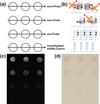Evaluating the sensitivity of hybridization-based epigenotyping using a methyl binding domain protein
- PMID: 24824477
- PMCID: PMC4312478
- DOI: 10.1039/c4an00667d
Evaluating the sensitivity of hybridization-based epigenotyping using a methyl binding domain protein
Abstract
Hypermethylation of CpG islands in gene promoter regions has been shown to be a predictive biomarker for certain diseases. Most current methods for methylation profiling are not well-suited for clinical analysis. Here, we report the development of an inexpensive device and an epigenotyping assay with a format conducive to multiplexed analysis.
Figures




Similar articles
-
An examination of critical parameters in hybridization-based epigenotyping using magnetic microparticles.Biotechnol Prog. 2018 Nov;34(6):1589-1595. doi: 10.1002/btpr.2644. Epub 2018 Jul 27. Biotechnol Prog. 2018. PMID: 29693329 Free PMC article.
-
Methyl-CpG-binding protein MBD2 plays a key role in maintenance and spread of DNA methylation at CpG islands and shores in cancer.Oncogene. 2017 Mar;36(10):1328-1338. doi: 10.1038/onc.2016.297. Epub 2016 Sep 5. Oncogene. 2017. PMID: 27593931
-
CpG island promoter methylation and silencing of 14-3-3sigma gene expression in LNCaP and Tramp-C1 prostate cancer cell lines is associated with methyl-CpG-binding protein MBD2.Oncogene. 2006 Aug 3;25(33):4559-72. doi: 10.1038/sj.onc.1209462. Epub 2006 Jun 19. Oncogene. 2006. PMID: 16786000 Free PMC article.
-
Methyl-CpG-binding proteins in cancer: blaming the DNA methylation messenger.Biochem Cell Biol. 2005 Jun;83(3):374-84. doi: 10.1139/o05-035. Biochem Cell Biol. 2005. PMID: 15959563 Review.
-
Mammalian methyltransferases and methyl-CpG-binding domains: proteins involved in DNA methylation.Curr Top Microbiol Immunol. 2000;249:55-74. doi: 10.1007/978-3-642-59696-4_4. Curr Top Microbiol Immunol. 2000. PMID: 10802938 Review. No abstract available.
Cited by
-
Microfluidic epigenomic mapping technologies for precision medicine.Lab Chip. 2019 Aug 21;19(16):2630-2650. doi: 10.1039/c9lc00407f. Epub 2019 Jul 24. Lab Chip. 2019. PMID: 31338502 Free PMC article. Review.
-
Substituent Effects of Fluorescein on Photoredox Initiating Performance under Visible Light.ACS Omega. 2023 Oct 18;8(43):40277-40286. doi: 10.1021/acsomega.3c04324. eCollection 2023 Oct 31. ACS Omega. 2023. PMID: 37929095 Free PMC article.
-
An examination of critical parameters in hybridization-based epigenotyping using magnetic microparticles.Biotechnol Prog. 2018 Nov;34(6):1589-1595. doi: 10.1002/btpr.2644. Epub 2018 Jul 27. Biotechnol Prog. 2018. PMID: 29693329 Free PMC article.
-
Hybridization-based CpG methylation level detection using methyl-CpG-binding domain-fused luciferase.Anal Bioanal Chem. 2023 May;415(12):2329-2337. doi: 10.1007/s00216-023-04657-z. Epub 2023 Mar 24. Anal Bioanal Chem. 2023. PMID: 36961575
-
Engineering affinity agents for the detection of hemi-methylated CpG sites in DNA.Mol Syst Des Eng. 2016 Oct 1;1(3):273-277. doi: 10.1039/C6ME00073H. Epub 2016 Sep 7. Mol Syst Des Eng. 2016. PMID: 28580176 Free PMC article.
References
-
- Ludwig JA, Weinstein JN. Nat Rev Cancer. 2005;5:845–856. - PubMed
-
- Herman JG, Baylin SB. New England Journal of Medicine. 2003;349:2042–2054. - PubMed
-
- Hartmann O, Spyratos F, Harbeck N, Dietrich D, Fassbender A, Schmitt M, Eppenberger-Castori S, Vuaroqueaux V, Lerebours F, Welzel K, Maier S, Plum A, Niemann S, Foekens JA, Lesche R, Martens JWM. Clinical Cancer Research. 2009;15:315–323. - PubMed
-
- deVos T, Tetzner R, Model F, Weiss G, Schuster M, Distler J, Steiger KV, Grützmann R, Pilarsky C, Habermann JK, Fleshner PR, Oubre BM, Day R, Sledziewski AZ, Lofton-Day C. Clinical Chemistry. 2009;55:1337–1346. - PubMed
Publication types
MeSH terms
Substances
Grants and funding
LinkOut - more resources
Full Text Sources
Other Literature Sources

